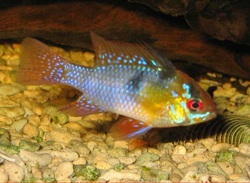German Blue Ram

Blue Ram, also know as German Blue Ram, Asian Ram, Butterfly Cichlid, Golden Ram and Ramirez's Dwarf Cichlid, should be kept in a relatively large tank otherwise they can get aggressive. Also, their natural environment consists of densely planted aquatic plants it is therefore advised that you place some in the aquarium.
Care: Moderate
Lifespan: 3 years
pH: 5-7
Temp: 25 - 30*C (77-86*F)
Size: 7 cm (2.7 in)
Min Tank: 75 L (20 gallons) for one pair, double volume if you wish to keep two pairs etc.
Breeding
Sexing: female is usually smaller, fatter and had more pink coloration than the male. Also, the females have a black stripe on the pelvic fin that the males don't have. Whilst the males have pointier dorsal and anal fins. Another great way to sex the Ram is by looking at their dorsal fin, the male will have a very long dorsal fin that bends backwards while the female dorsal fins will remain short.
To breed this fish you need to provide a flat stone on which the female will layer her eggs on, she will lay 150-300 eggs which hatch in about 40 hours. It is also recommended that you start with a water temperature of 26*C (78.8*F) and gradually move it up to 28 °C (82 °F). The lighting should be organised to that its is in sync with the natural day light and night time cycle so that the rams don't get confused as this can stop them from breeding. Sometimes the pair might dig a small ditch in the gravel in which the female will lay her eggs. During spawning time the females pink coloration will brighten, maybe even start to look red, and she will start to swell up with eggs. After this the pair will often be seen courting and nudging each other and eventually spawn.
When the eggs hatch the parents will look after the fry and won't eat them (however they parents will eat unfertile eggs to avoid bacterial growth from affecting the other eggs). They will protect them from any potential threats and may be aggressive towards other fishes in the tank. The fry can be fed crushed flakes and baby brine shrimp.
Care: Moderate
Lifespan: 3 years
pH: 5-7
Temp: 25 - 30*C (77-86*F)
Size: 7 cm (2.7 in)
Min Tank: 75 L (20 gallons) for one pair, double volume if you wish to keep two pairs etc.
Breeding
Sexing: female is usually smaller, fatter and had more pink coloration than the male. Also, the females have a black stripe on the pelvic fin that the males don't have. Whilst the males have pointier dorsal and anal fins. Another great way to sex the Ram is by looking at their dorsal fin, the male will have a very long dorsal fin that bends backwards while the female dorsal fins will remain short.
To breed this fish you need to provide a flat stone on which the female will layer her eggs on, she will lay 150-300 eggs which hatch in about 40 hours. It is also recommended that you start with a water temperature of 26*C (78.8*F) and gradually move it up to 28 °C (82 °F). The lighting should be organised to that its is in sync with the natural day light and night time cycle so that the rams don't get confused as this can stop them from breeding. Sometimes the pair might dig a small ditch in the gravel in which the female will lay her eggs. During spawning time the females pink coloration will brighten, maybe even start to look red, and she will start to swell up with eggs. After this the pair will often be seen courting and nudging each other and eventually spawn.
When the eggs hatch the parents will look after the fry and won't eat them (however they parents will eat unfertile eggs to avoid bacterial growth from affecting the other eggs). They will protect them from any potential threats and may be aggressive towards other fishes in the tank. The fry can be fed crushed flakes and baby brine shrimp.
Courtesy of Cheddar232, visit his channel!
Go fullscreen to watch.
Go fullscreen to watch.

